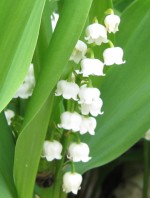 Native to woodlands in colder parts of Europe and Asia, this herbaceous perennial grows 6-12″ tall from a rhizomatous root system and often form large colonies. Each plant has one to three basal leaves that are about eight inches long. Five to fifteen fragrant nodding flowers are carried on one sided arching racemes in early spring. The bell-shaped flowers are usually white, sometimes pink, and consist of five fused tepals.
Native to woodlands in colder parts of Europe and Asia, this herbaceous perennial grows 6-12″ tall from a rhizomatous root system and often form large colonies. Each plant has one to three basal leaves that are about eight inches long. Five to fifteen fragrant nodding flowers are carried on one sided arching racemes in early spring. The bell-shaped flowers are usually white, sometimes pink, and consist of five fused tepals.
Lily of the valley is also known as ‘Our Lady’s Tears’ or ‘Mary’s tears’ in reference to the story that as the Virgin cried at her son’s crucifixion her tears produced flowers as they touched the ground at the foot of the cross. A reading of the passages in the Bible relating to the crucifixion reveals that only one of the 4 Gopels (John) cites the presence of Mary at her son’s crucifixion and none of the passages mention tears, crying, or any flower.
Other legends link lily of the valley to Eve (who cried when expelled from the Garden of Eden), Ostara (the Norse goddess of spring and dawn), the Greek god Apollo ( who grew them to protect the feet of his muses in the woods), and St Leonard of Noblac (when fighting his battle with dragons).
Lily of the valley is very fragrant and often used in fresh arrangements as well as bridal bouquets. It makes a splendid ground cover in shade and can be used in borders and rock gardens with care to restrain its very rambunctious ways. Plants like full to partial shade and fertile, moderately, well-drained soil in USDA Hardiness Zones 3-8. Aphids, spidermites, stem rot, leaf spot, and leaf blotch can cause problems. Propagation is by division.
The genus name, Convallaria, comes from the Latin word convallis meaning valley and refers to the late medieval name for the plant, Lilium convallium, taken from the Vulgate Bible translation of the Song of Solomon. The specific epithet, majalis, is the Latin word meaning May-flowering, and refers to the time when the plant blooms.